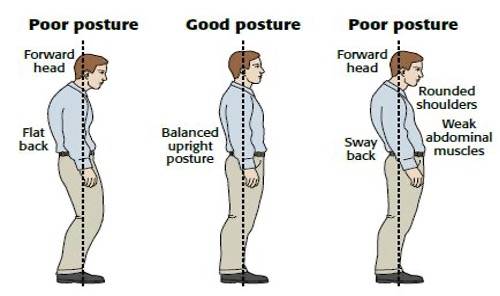Perfect Your Posture
Good posture is something we all strive for, but it’s hard when routine activities throughout everyday life can put a strain on our posture. Things such as stress caused by working from home or the hours spent sitting slouched over gaming devices impact our body’s ability to achieve and maintain good posture.
To maintain good posture, you need to have balance, muscle flexibility and strength, and normal joint motion throughout the body, particularly the spine. This means you not only need to be aware of correcting postural and movement habits at work, home, and while doing life.
What is good posture and why is it important?
Good posture is more than just standing tall and looking your best, it’s an important part of your overall health and well-being. Posture is simply the body’s position and alignment while at rest or in motion. One of the key components to good posture is the position of your spine and the body’s ability to function optimally.
Poor posture can have a direct negative impact on our bodies, both physically and mentally.
How to Improve Your Posture
As we get older, bad habits such as slouching and inactivity cause muscle fatigue and tension that ultimately lead to poor posture. Perhaps you have one shoulder higher than the other or a tilted pelvis – over time, these imbalances can have a serious impact on the body’s central nervous system. That’s where chiropractic comes in.
Chiropractors can help improve posture by adjusting the spine, reducing joint restrictions, strengthening the supporting muscles and soft tissue in the neck and upper back, reducing inflammation, and educating people on ways to maintain proper posture. By correcting imbalances and encouraging your body to work more optimally, you can better support good posture.
Did you know that balance-specific workouts can address posture and balance problems, by doing exercises that build strength where it counts? Also doing stretches that loosen tight muscles, increasing core strength and working on your flexibility can help you improve your posture noticeably in just a few weeks.
You can improve your posture with a few simple exercises:
- Chin tuck. While seated in a chair with your feet flat on the floor and shoulders relaxed. Hold your head upright. Pull your chin in toward your neck; hold that position for a count of five; then relax. Repeat 10 times. To help guide your head, you can gently apply pressure to your chin with two fingers if needed.
- Shoulder blade squeeze. Sit up straight in a chair with your hands resting on your thighs. Keep your shoulders down and your chin level. Slowly draw your shoulders back and squeeze your shoulder blades together. Hold for a count of five; relax. Repeat three or five times.
- Abdominal pull-in. While seated or standing, inhale; then exhale slowly to a count of five, pulling your lower abdominal muscles up and in, as if moving your belly button toward your backbone. Relax and breathe normally. Repeat three or five times.
- Upper-body stretch. Stand facing a corner with your arms raised, hands flat against the walls, elbows at shoulder height. Place one foot ahead of the other. Bending your forward knee, exhale as you lean your body toward the corner. Keep your back straight and your chest and head up. You should feel a nice stretch across your chest. Hold this position for 20–30 seconds. Relax.

The back has three natural curves: a slight forward curve in the neck (cervical curve), a slight backward curve in the upper back (thoracic curve) and a slight forward curve in the low back (lumbar curve). When these curves are in proper alignment, the spine, shoulders, hips, knees, and ankles are in balance, and body weight is evenly distributed.
The payoff is less stress and strain on muscles, joints, and ligaments, and a reduced risk for back, neck, and shoulder pain. Some of the classic signs of poor posture are a potbelly, rounded shoulders, and a jutted-out neck and chin (known as a forward head position).
By standing up straight, you center your weight over your feet. This also helps you maintain correct form while exercising, which results in fewer injuries and greater gains. Your whole body will show you love when it’s able to move more efficiently.
Other ways you can improve your posture:
- Make posture checks throughout the day: keep your shoulders rolled back, your head held high and your spine as neutral as it can be.
- Strengthen your core. Consistently training the muscles around your spine and shoulders will make it easier to maintain a healthy posture.
- Make sure work surfaces are at a comfortable height for you, whether you’re sitting in front of a computer, making dinner, or eating a meal.
- Exercise: Moving and stretching often will keep your muscles stimulated and your posture long. Exercises that are designed to strengthen your core muscles that support your spine result in a straighter body.
- Breathe: Practice deep breathing in a standing position a couple of times daily which requires you to stand taller.
- Sleep right: Make sure the pillow you use supports your head and neck. We recommend the Therapeutica formed pillow made to measure.
- Avoid text neck: Try holding your phone at eye level when texting and browsing.
- Visit your Chiropractor: is the best resource for keeping aligned, keeping up with routine visits, even when you aren’t in pain, will keep your back healthy and your posture on point.
Over time, imbalances can have a serious impact on the body, we can educate you further on the benefits and risks associated with bad posture, provide a few tips you can take action on today, and extend our hand to help you on your journey to achieving and maintaining good posture.
We want you to live a functional life that is fulfilled with more energy, positive attitude, better sleep, and less pain. Our goal is to ultimately empower our patients to maintain the healthiest way of living. With a bit of work, we can achieve optimal health together, no matter the age, ability or disability.
Have questions?
Call us. We are here to help!
519-766-3940

The information is not intended to provide or be a substitute for professional medical advice, diagnosis, or treatment.
It is for informational purposes only.
.

